October 25, 2025
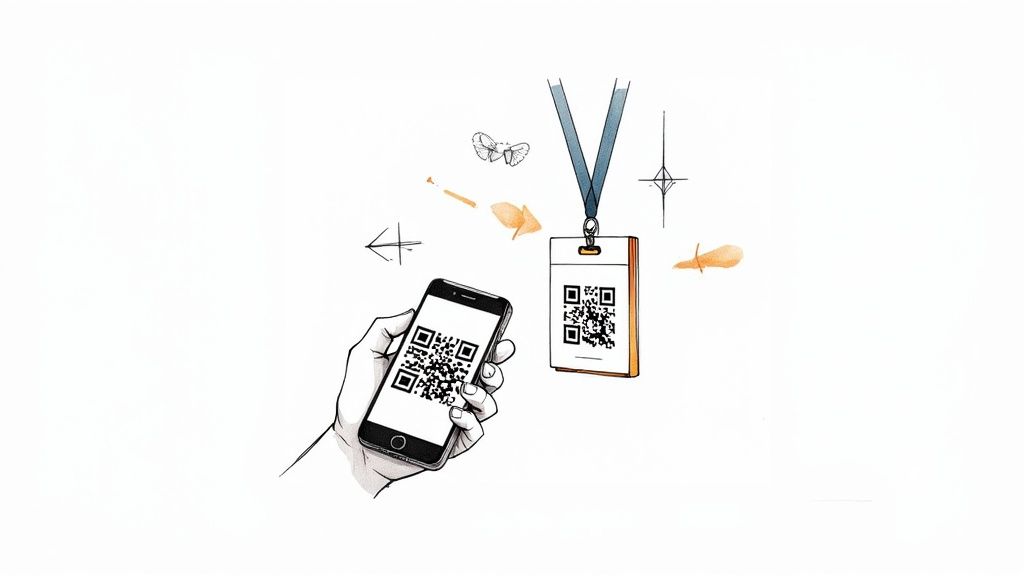
Most of us know the drill by now: open your phone’s camera, point it at one of those black-and-white squares, and tap the link that pops up. It’s a simple action that creates a powerful link between the physical and digital worlds. For anyone running events or managing a community, that simple link is the key to creating effortless check-ins, handling payments, and sharing content without missing a beat.
If you still think of QR codes as just a gimmick for sharing a website, it’s time to look again. They’ve become a must-have tool for modern event organizers, solving some of the most persistent logistical headaches we all face. Forget the days of juggling spreadsheets and dealing with long, slow-moving registration lines—a quick scan is all it takes now.
This isn't just a small trend, either. The global QR code market has ballooned to $13.04 billion, and the number of scans shot up by 57% globally just between 2022 and 2023. That kind of growth tells you one thing: this technology works. For more data on this surge, you can check out the latest findings on qr-insights.com.
For event managers, the real magic of QR codes is how much they can do. A single scan can handle way more than just marking someone as "attended."
Think about it. An attendee walks up and scans the code on their ticket. With a platform like GroupOS, that one action can simultaneously:
This creates a polished, professional experience right from the get-go. Your attendees feel like VIPs, and your team isn’t bogged down with manual, repetitive tasks.
The beauty of a QR code is its ability to transform a static piece of paper—like a ticket or a poster—into a dynamic, interactive gateway. It’s the simplest way to connect your physical event space with your digital engagement strategy.
QR codes are incredibly useful in events and community management. I've found they're most effective when applied to specific, high-friction points in the attendee journey.
Here’s a quick breakdown of where they can make the biggest impact:
By thinking through these applications, you can start to see how QR codes are less of a novelty and more of a core operational tool.
Don't forget about the role QR codes play in your marketing. If you're building out a plan for how to promote an event, they are a fantastic way to bridge your physical and digital campaigns. You can put them on flyers, posters, and even social media graphics to drive people directly to your registration page.
This direct link is a cornerstone of smart event management. By connecting your marketing materials straight to your ticketing platform, you remove any friction and capture potential attendees the moment you have their attention. For more ideas on how to weave this into your strategy, take a look at our guide on proven event marketing ideas.
Let's be clear: mastering the use of QR codes is no longer optional. It’s an essential skill for running efficient, engaging, and profitable events.
Alright, let's move from theory to action. Getting your first QR code set up for an event check-in is where the magic really happens. While it might seem like you just click a button and you're done, building a system that's reliable, secure, and genuinely easy for your guests requires a bit more planning. The last thing you want is a technical headache at the door.
Your first major decision is choosing between a static and a dynamic QR code. A static code is simple—it permanently locks the destination link right into the QR pattern. Once it's printed, that's it. You can't change it, and you can't track it.
A dynamic QR code, on the other hand, is the professional's choice. It points to a special short URL that you control. This means you can change where that QR code sends people at any time, even after it's been printed. For any live event, this is really the only way to go.
Let's play out a common scenario. You’ve just printed 500 event programs, each with a QR code. Then you spot it: a typo in the URL. If you used a static code, you’d have a big, expensive problem. But with a dynamic code managed through a platform like GroupOS, you just log in, fix the link, and you're done. No reprinting needed.
That kind of flexibility is a lifesaver. But the real power comes from the data. Dynamic codes let you track every single scan, giving you a real-time look at who's checking in and when. This is gold for understanding attendee flow and measuring engagement.
For any event, always go with dynamic QR codes. The ability to update the destination on the fly and track scans gives you a level of control and insight that static codes just can't match.
This whole process is about more than just getting people in the door. A single QR code can power the entire event experience, from check-in and payments to accessing exclusive content.
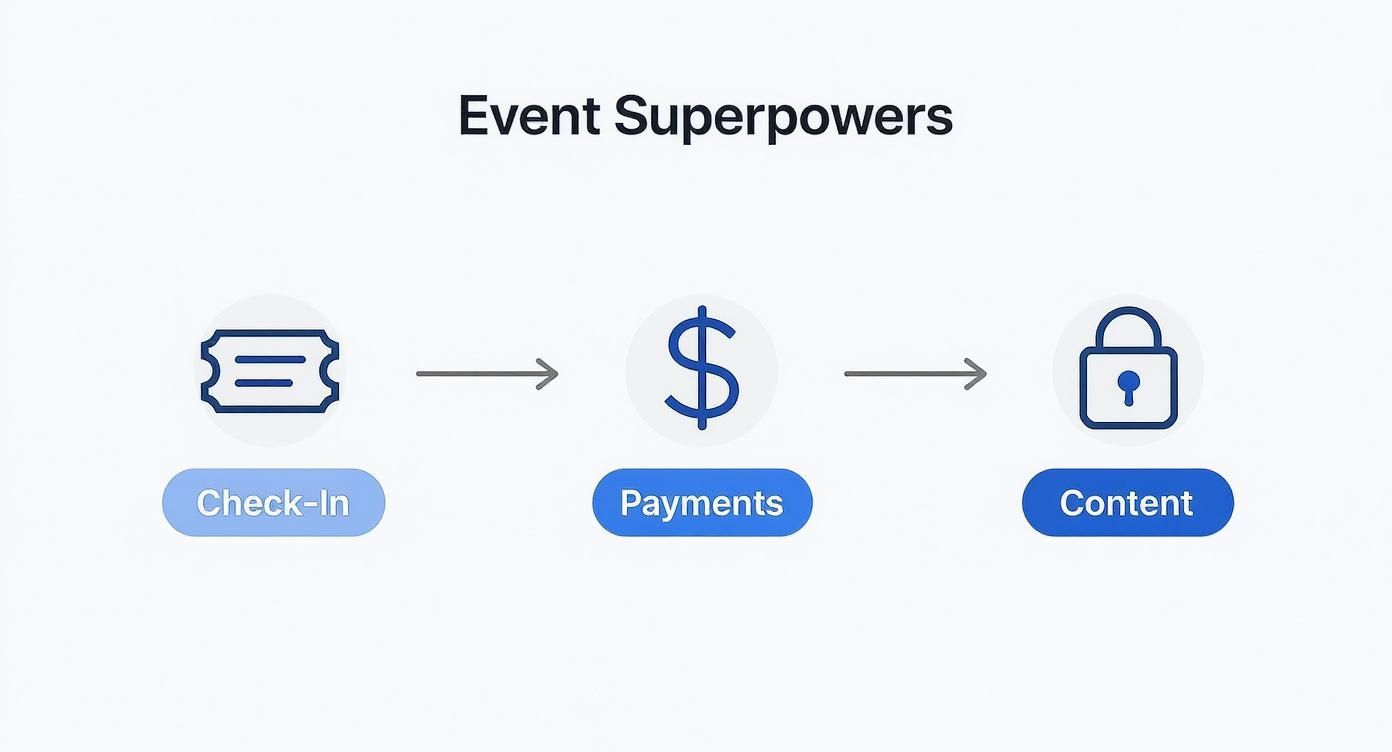
As you can see, what starts as a simple scan can trigger a whole series of actions, making the QR code an indispensable tool from start to finish.
For a truly secure and speedy check-in, the key is assigning a unique QR code to each attendee. A generic code that just points everyone to the same registration page can't actually validate a ticket, creating a messy situation at the entrance.
Here’s a look at how it works inside a proper event management system:
This one-to-one connection is what makes an event check-in app so powerful. When your staff scans the code, the app instantly confirms the guest's identity and ticket status, then marks them as checked in. The whole interaction takes seconds.
While we're focused on events here, the principles for creating smart QR codes apply in many other areas. For instance, you can see similar strategies in guides like How to Create QR Codes for Rental Properties. By following these steps, you’ll have a professional, event-ready QR system that works every time.
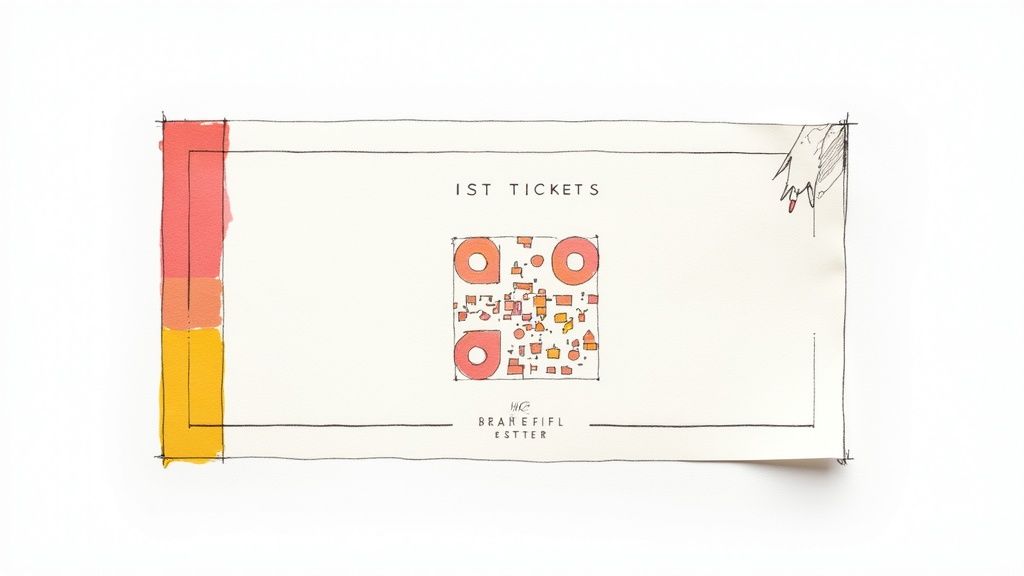
Sure, a standard black-and-white QR code works. But a branded one creates an experience. Customizing your QR code is one of the easiest, yet most effective, ways to turn a purely functional tool into a memorable brand touchpoint. This isn't just about making things look pretty; it's about building trust and reinforcing your event's professional identity from the very first scan.
Think about it. When you weave your brand's colors and logo into the code, you transform a generic square into something that is undeniably yours. This visual consistency is so important for creating a cohesive journey for your attendees, whether they see the code on a digital ticket, a massive printed banner, or a small welcome sign. A branded code instantly signals to people that they're in the right place and that the interaction is secure and official.
As you start playing with the design, remember the number one rule: it has to be scannable. A beautiful code that doesn’t work is completely useless. The trick is to find that sweet spot between creative flair and technical function.
I've seen people get a little too creative and end up with codes that phones can't read. To avoid that, just stick to these core principles:
Thankfully, platforms like GroupOS have built-in customization tools that guide you. They let you get creative with your design while adding safeguards to ensure the code's integrity isn't compromised.
A custom QR code does more than just look good—it genuinely drives results. Marketing studies have shown that adding a QR code to print materials can lift engagement by 30%. It's why 70% of marketers now see them as a crucial part of their strategy. For events specifically, a branded code on a ticket can increase an attendee's trust by as much as 40%. You can dig into more of these stats in a great Barkoder.com report.
A branded QR code signals professionalism. It shows you've considered every detail of the attendee experience, turning a simple check-in process into a seamless extension of your event's identity.
This level of detail reinforces your organization’s image and elevates how people perceive your event. For a deeper look at how visual identity shapes an event's success, check out our guide on effective branding for events. In the end, a branded QR code isn't just a fancy link; it's a small but powerful statement about your brand's commitment to a quality experience.
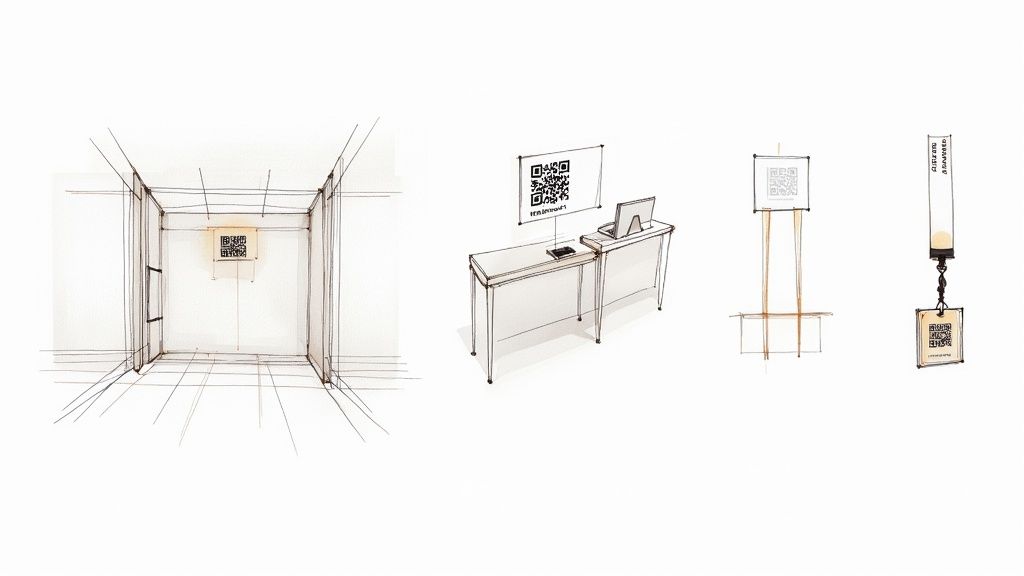
A great-looking QR code is a fantastic start, but honestly, it’s only half the battle. If your attendees can't easily find and scan it, all that design work is for nothing. Where you put your QR codes—and how you display them—is just as crucial as the code itself. Good placement is what turns a simple black-and-white square into a powerful tool for engagement.
Think about the entire attendee journey, from the moment they register to the time they walk through the door. The best spots for QR codes are natural touchpoints along that path. A perfect example is putting a unique check-in code right in their confirmation email. They get everything they need upfront, which makes for a much smoother, more professional arrival experience on event day.
Once your guests are actually at the venue, placement becomes even more critical. The goal here is to make scanning a completely obvious and effortless action. After running countless events, I’ve found a few key locations that consistently deliver the best results for check-ins and quick sign-ups.
Try placing large, clear QR codes on:
Just as important is knowing where not to put them. Stay away from poorly lit corners, surfaces with a lot of glare (like a glossy poster behind glass), or anywhere a crowd is likely to block the view. The easier you make the physical act of scanning, the more people will actually do it.
Your QR code should never feel like a scavenger hunt. Put it in plain sight, make sure it’s well-lit, and print it large enough to be scanned from a comfortable distance. This small detail makes a massive difference in the attendee experience.
Beyond just the location, a few practical details can make or break scannability. One of the most common mistakes I see is printing the code way too small. For most on-site materials like flyers or table tents, your QR code needs to be at least 1x1 inch (or 2.5x2.5 cm). That’s the minimum for a reliable scan from any smartphone camera. If you're putting it on a large banner meant to be seen from a distance, you’ll need to scale that up—a lot.
The material you print on matters, too. I always recommend matte finishes over glossy ones because they prevent reflective glare from messing with the phone's camera. If you’re displaying a code on a digital screen, just crank up the brightness and make sure the contrast is high.
Finally, and this is crucial, always pair your QR code with a clear call-to-action (CTA). Don’t just slap a code on a sign and hope for the best. Tell people exactly what to do. Simple instructions like "Scan Here to Check-In" or "Get the Event Schedule" remove all the guesswork and prompt people to pull out their phones. It’s this combination of smart placement and clear direction that really makes QR codes work.
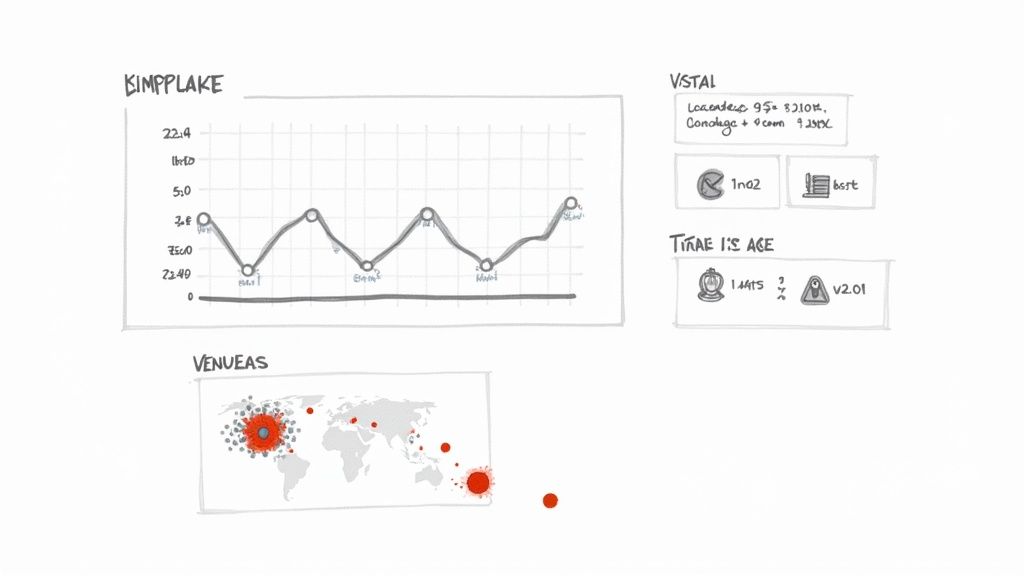
The real magic of a dynamic QR code isn't just the scan itself; it's the story the data tells you afterward. Every time someone checks in, you're collecting a crucial piece of information about your event's flow and your audience's behavior. This is how you shift from just running an event to truly understanding it.
Analyzing this scan data gives you powerful insights that used to be incredibly difficult to get. Instead of just guessing when the morning rush was, you can see it graphed out, minute by minute. This data-driven approach is key to proving your event's value and making much smarter decisions for the next one.
When you manage your QR codes through a platform like GroupOS, you get access to a dashboard packed with valuable metrics. Don't let the numbers overwhelm you. Just focus on a few key data points that paint the clearest picture of what happened on the ground.
Here are the metrics I always keep a close eye on:
By watching these numbers in real-time, you can even spot bottlenecks as they happen. If you see a massive surge in scans that’s causing a long line, you can immediately send more staff to open another check-in point. Suddenly, your data becomes an active operational tool.
The goal of tracking QR code scans is to replace assumptions with certainty. You no longer have to guess about attendee behavior—the data shows you exactly how your event unfolded, moment by moment.
Consumer trust in QR codes makes this data incredibly reliable. This comfort level goes far beyond just event check-ins. For example, the global QR code payment market is projected to hit $35.13 billion by 2029. With an estimated $3 trillion in transactions expected by 2025, it’s clear people see QR codes as a secure and normal part of life. You can explore more on these financial trends and adoption rates over on Coinlaw.io.
Ultimately, all this data is your roadmap for future improvement. Did you see a huge line forming just before the main keynote? Next year, you'll know to open the doors 15 minutes earlier or add more staff during that specific window.
To help you get started, here's a look at the most important metrics and what they reveal about your event's performance.
This information is also your best tool for demonstrating success. When you can show stakeholders precise attendance figures and detailed reports on guest flow, you're proving your event’s ROI with hard evidence. For a deeper dive, check out our complete guide on how to measure event success and put your data to work.
By learning to use QR codes effectively, you’re doing more than just managing logistics—you’re gathering the business intelligence you need to grow.
Even though QR codes are everywhere now, I still get a lot of the same questions when groups first start using them for events. Getting these fundamentals right is the key to a smooth, reliable system that won’t let you or your attendees down on the big day.
Let's clear up some of the most common points of confusion so you can build your check-in process with confidence.
This is probably the most important question of all, and the answer is simple. For any live event, you need a dynamic QR code.
A static QR code is a one-and-done deal. The information, like a website URL, is baked right into the code's pattern. Once you generate it, it can't be changed. It’s like printing a web address directly on a flyer—if the address changes, the flyer is useless.
A dynamic QR code, on the other hand, is a game-changer for events. It points to a special redirect link that you control. This means you can change the destination URL whenever you want, even after the code has been printed on thousands of tickets. More importantly, it lets you track every single scan. This is how you know who checked in and when.
For any professional event, dynamic QR codes are the only real option. The ability to track scans and update the destination link on the fly is non-negotiable for managing access and gathering data.
Thankfully, no. This is a common worry, but the days of needing a clunky, third-party QR reader app are long gone.
Nearly every modern smartphone—both iPhones and Androids—has a QR scanner built right into the native camera app. Your guest just opens their camera, points it at the code, and a little notification pops up to take them where they need to go. It’s that simple. This makes the whole process incredibly frictionless and accessible for just about everyone.
A code that refuses to scan can create a bottleneck at your front door—a true event manager's nightmare. Fortunately, avoiding this is easy if you follow a few best practices I've learned over the years.
Finally, people often ask if a QR code can just "expire" or stop working. A static one will work as long as the link it points to is still active. A dynamic code, like the ones you generate in a platform like GroupOS, is tied to your account. As long as your account is active, your codes will keep on working flawlessly.
Ready to create a seamless check-in experience for your next event? GroupOS provides all the tools you need to generate, manage, and track dynamic QR codes that integrate perfectly with your ticketing and membership systems. Start your free trial today and see how easy it can be.


